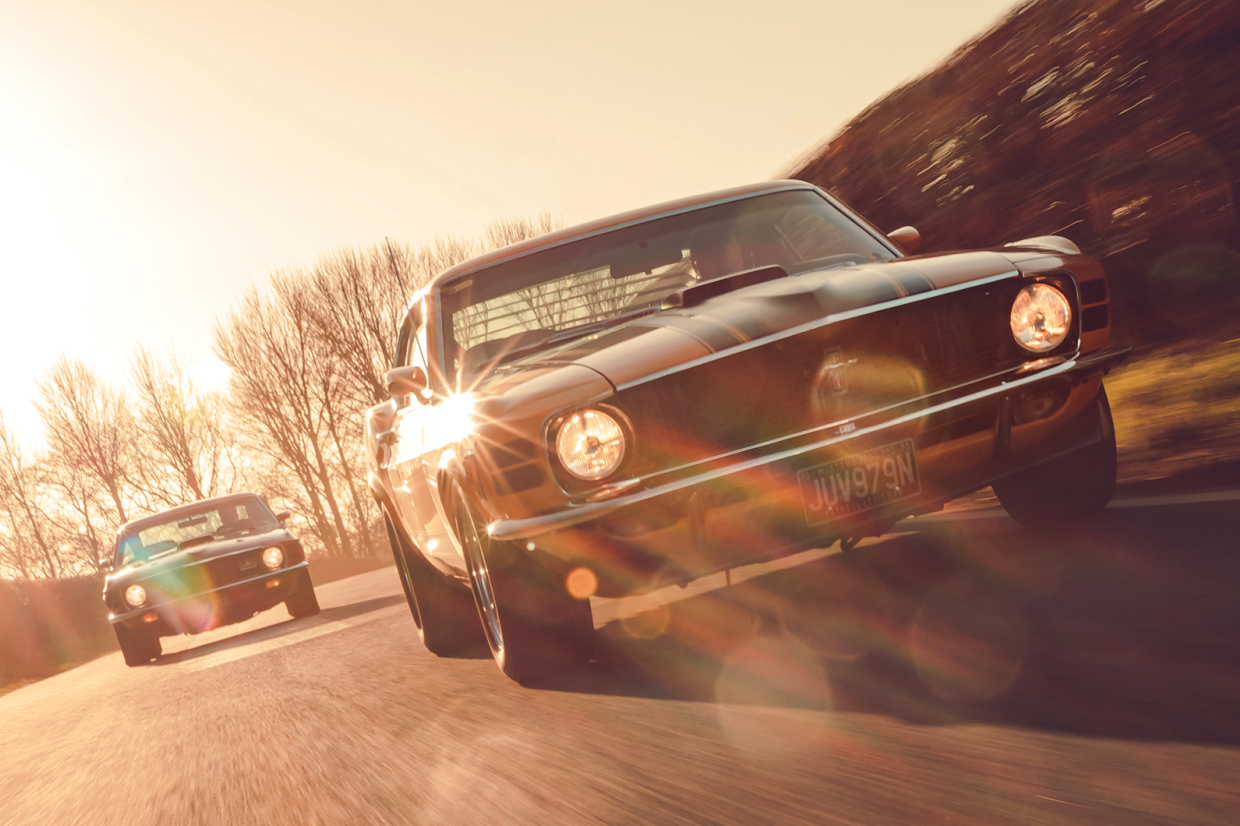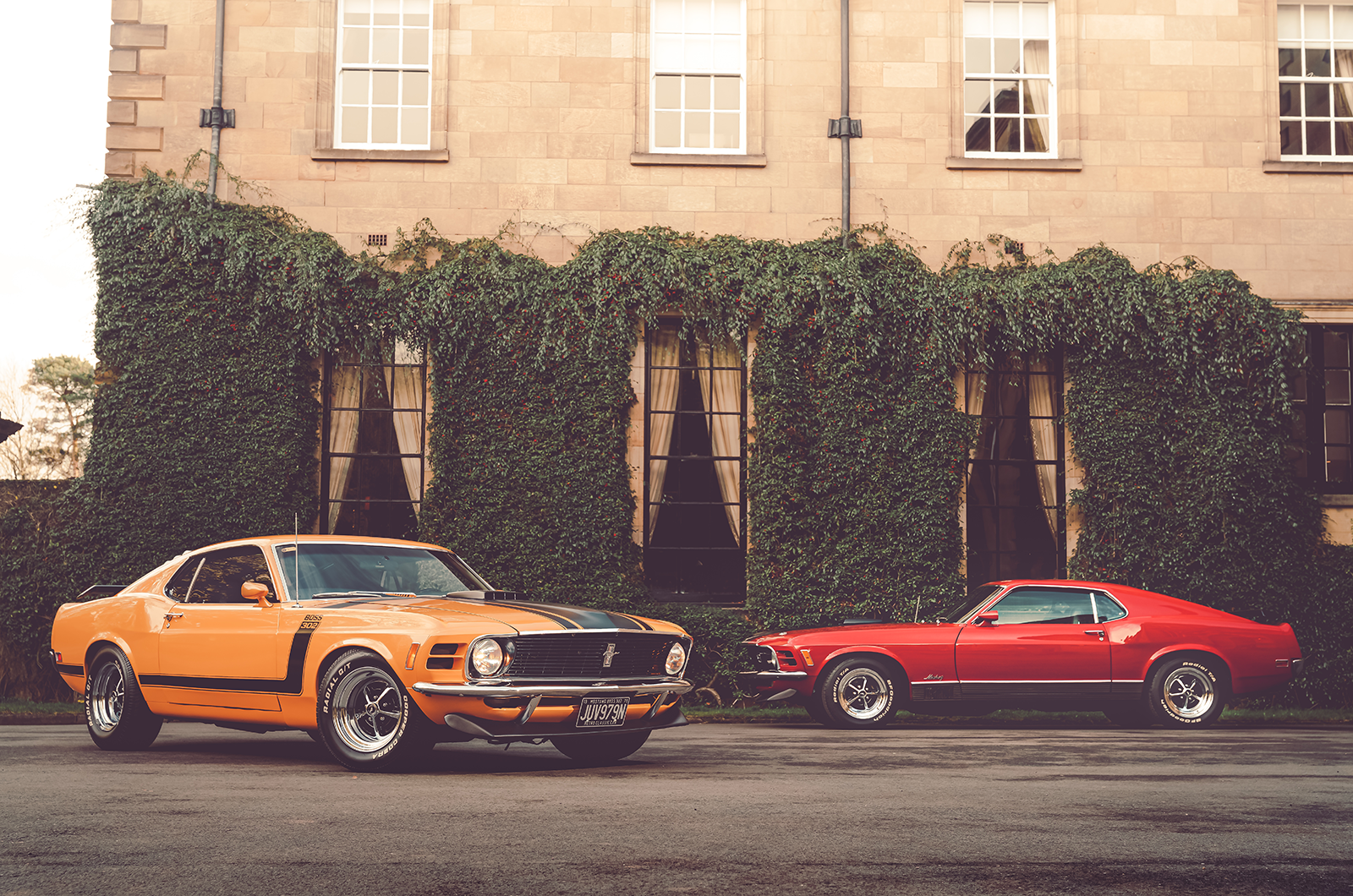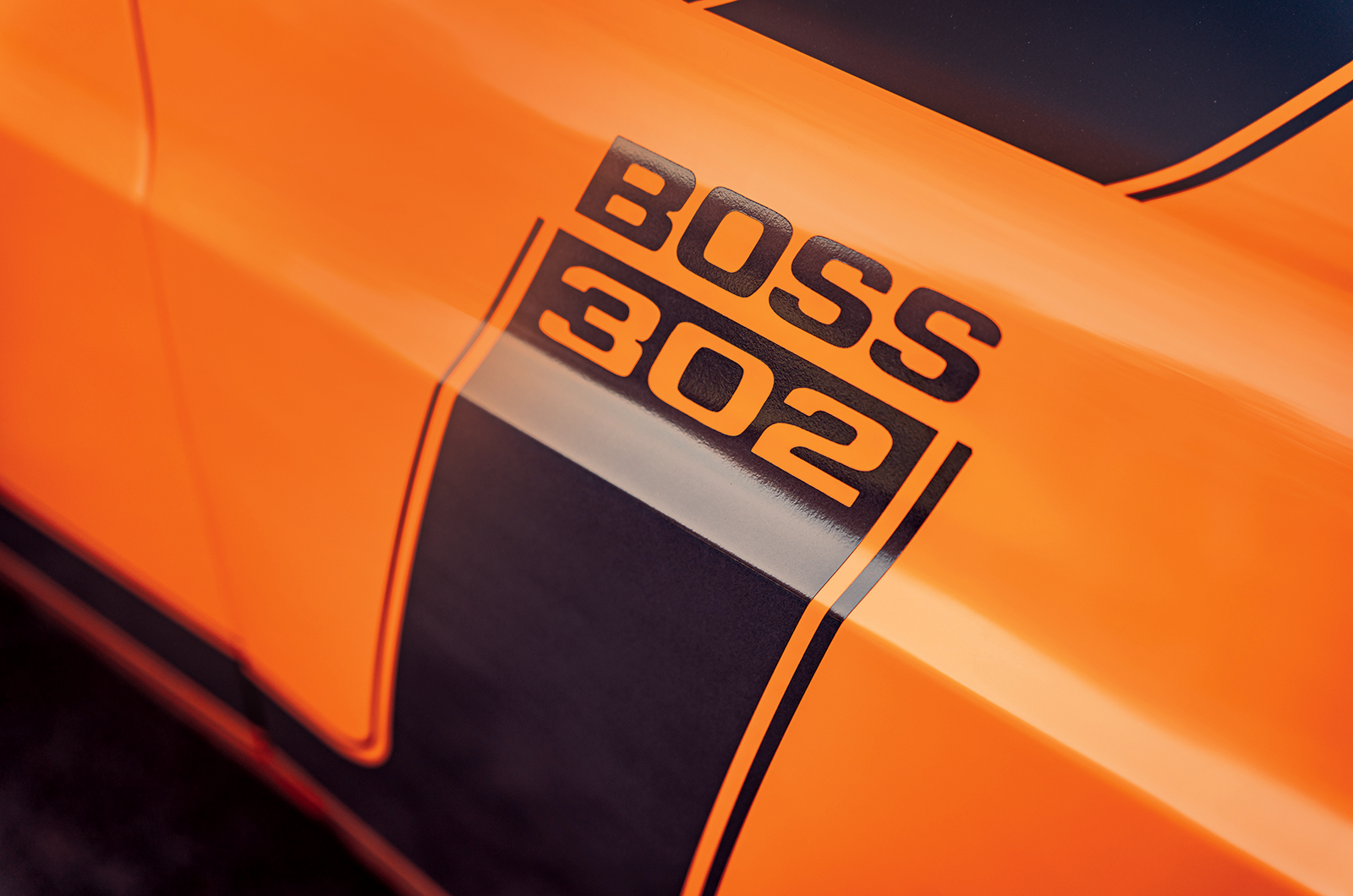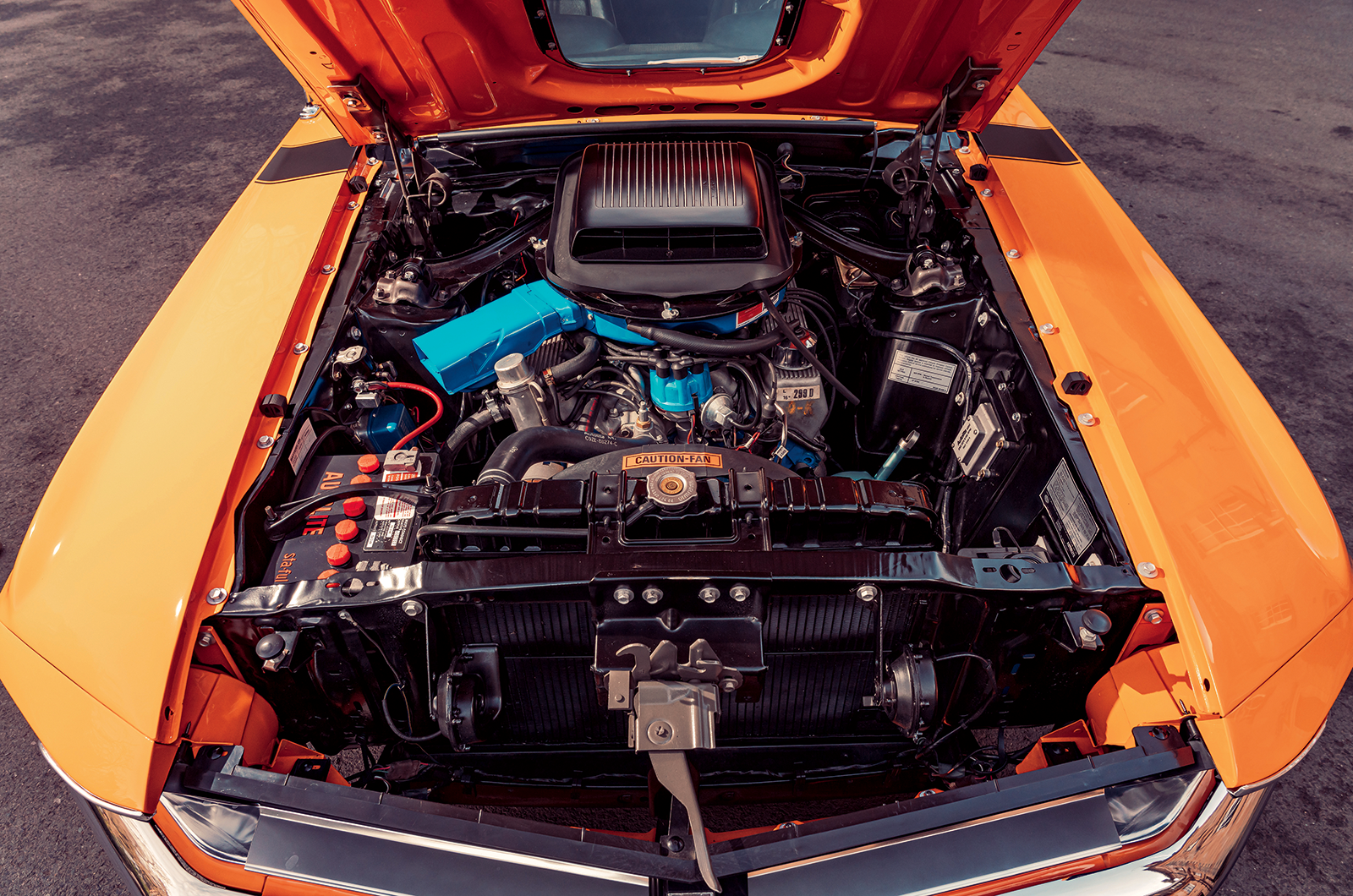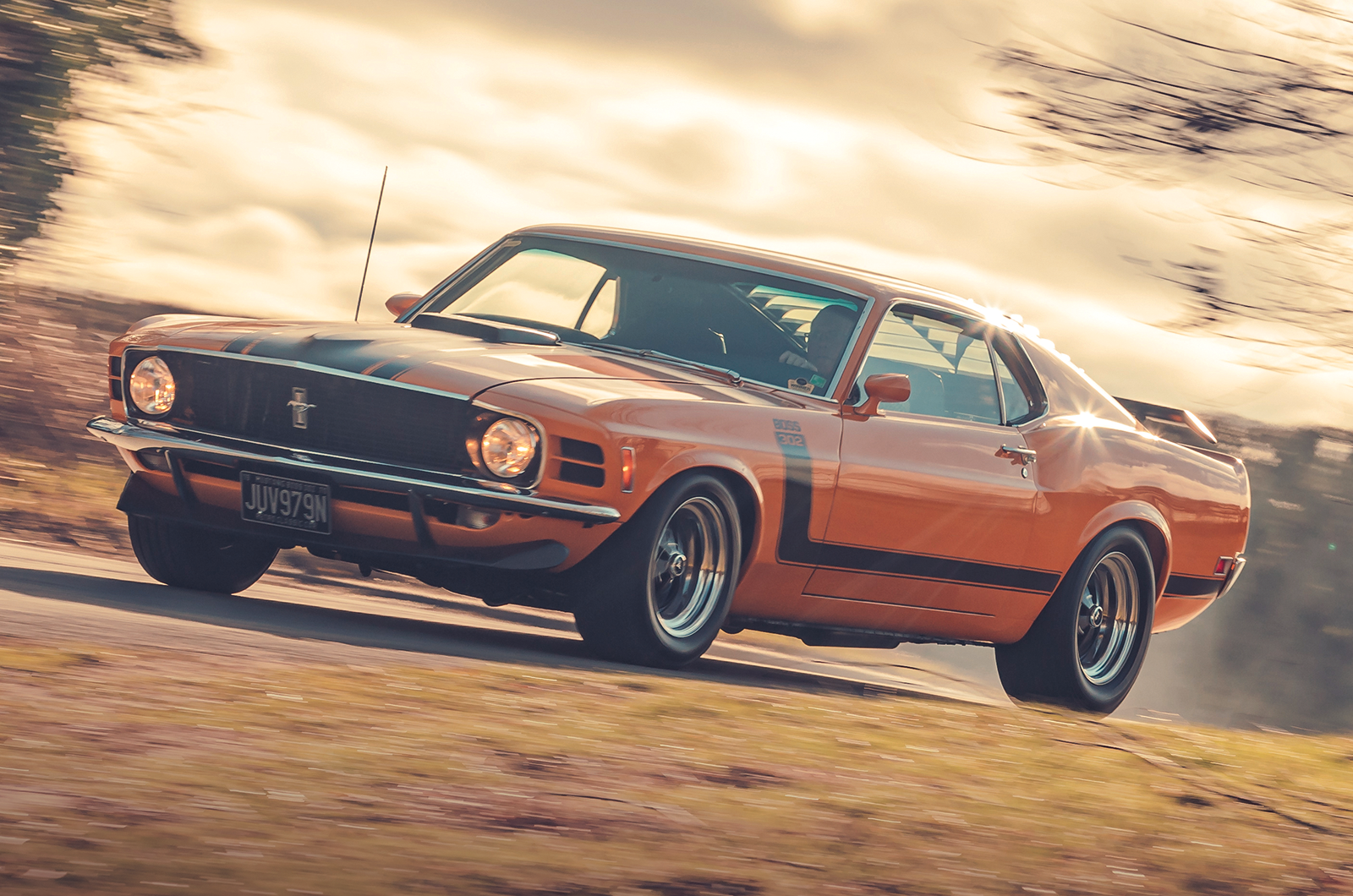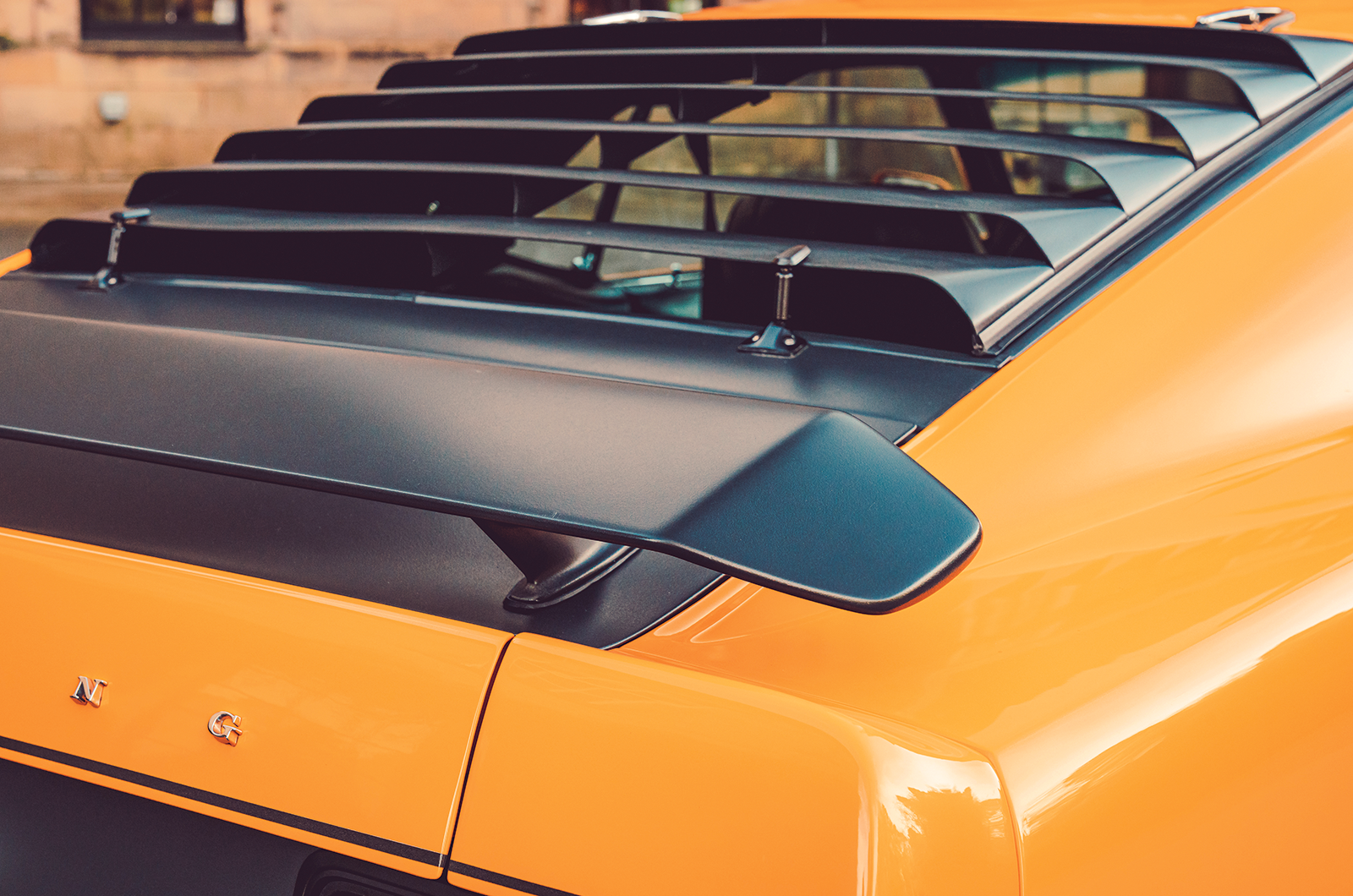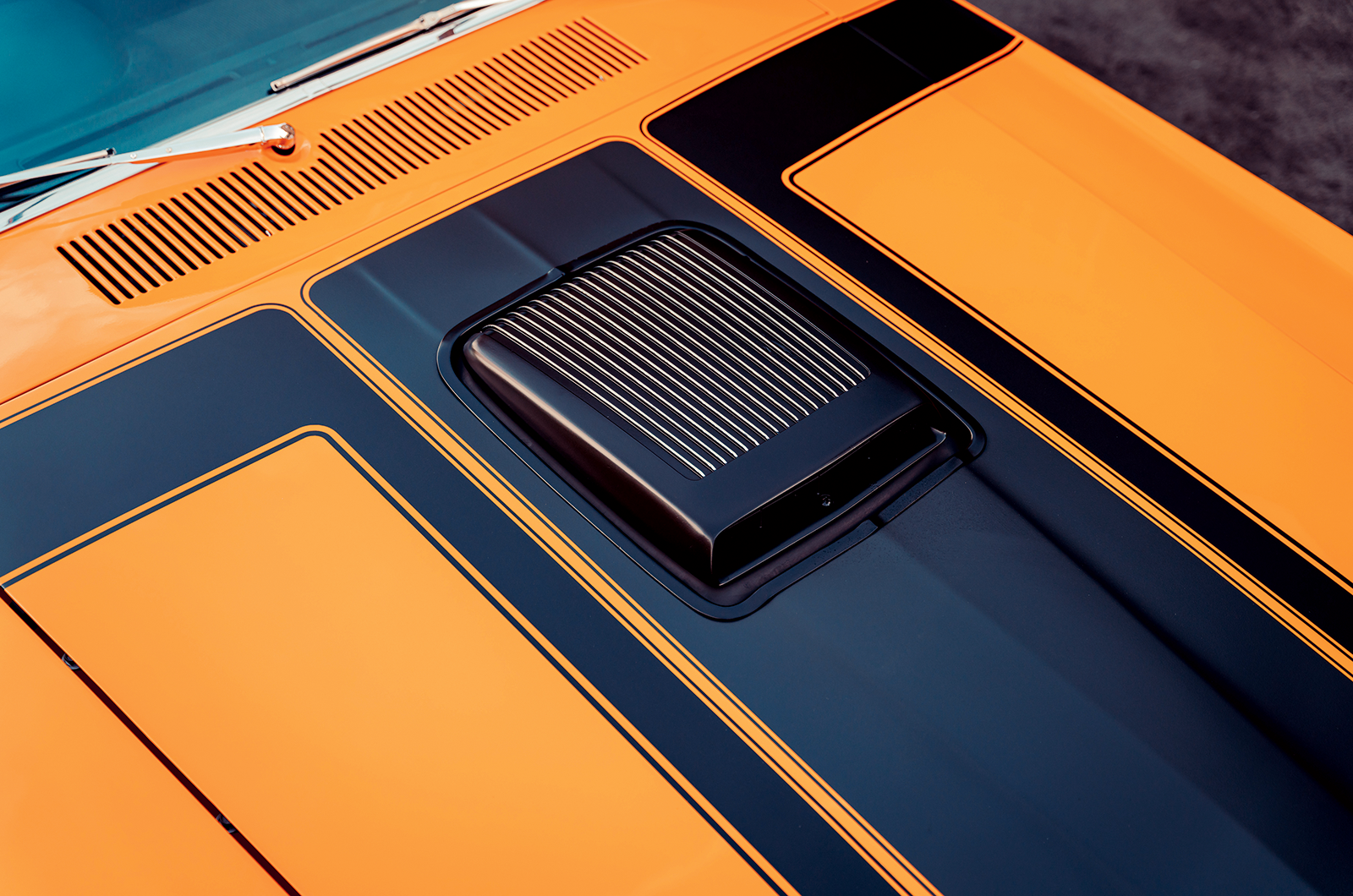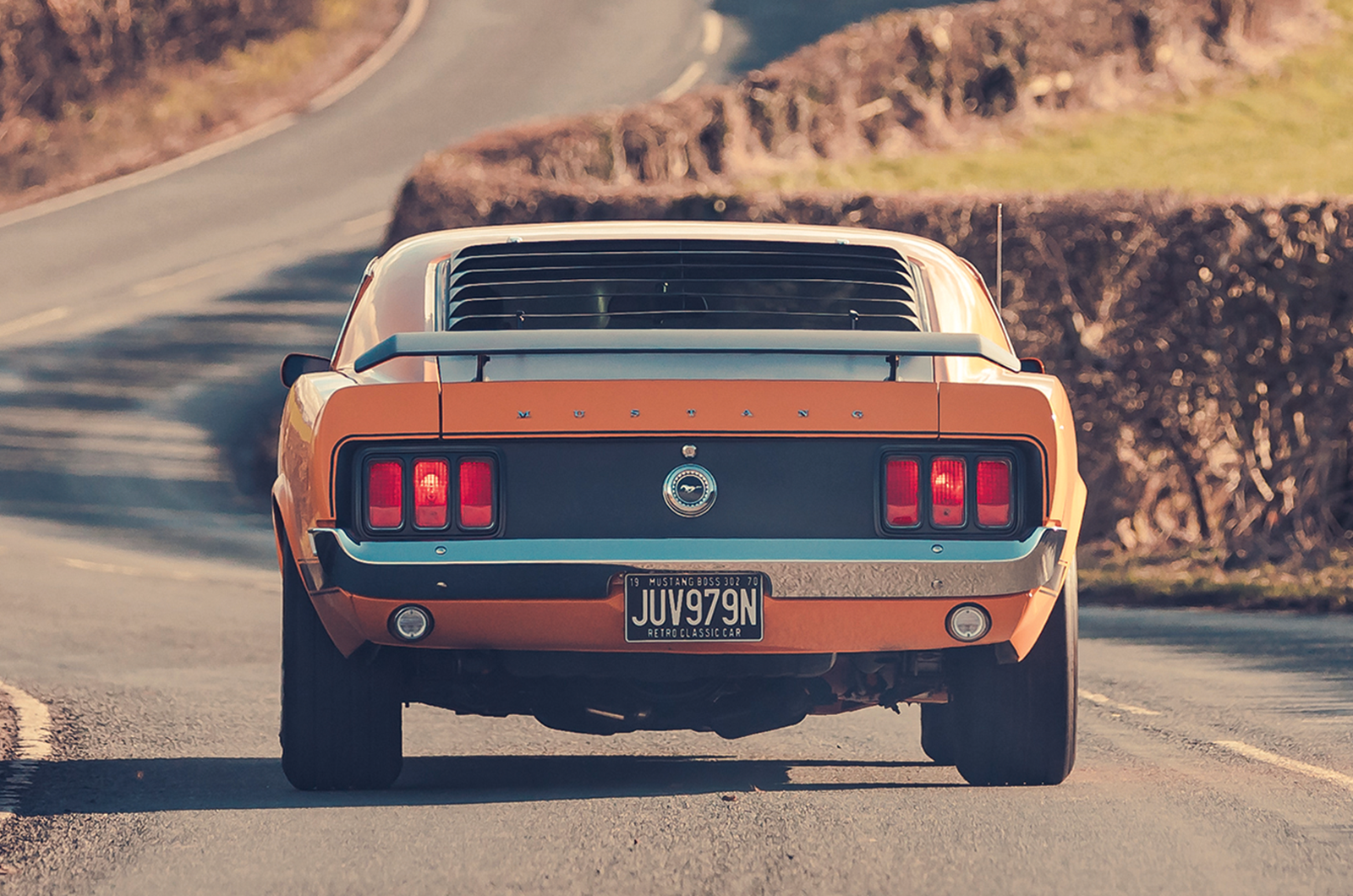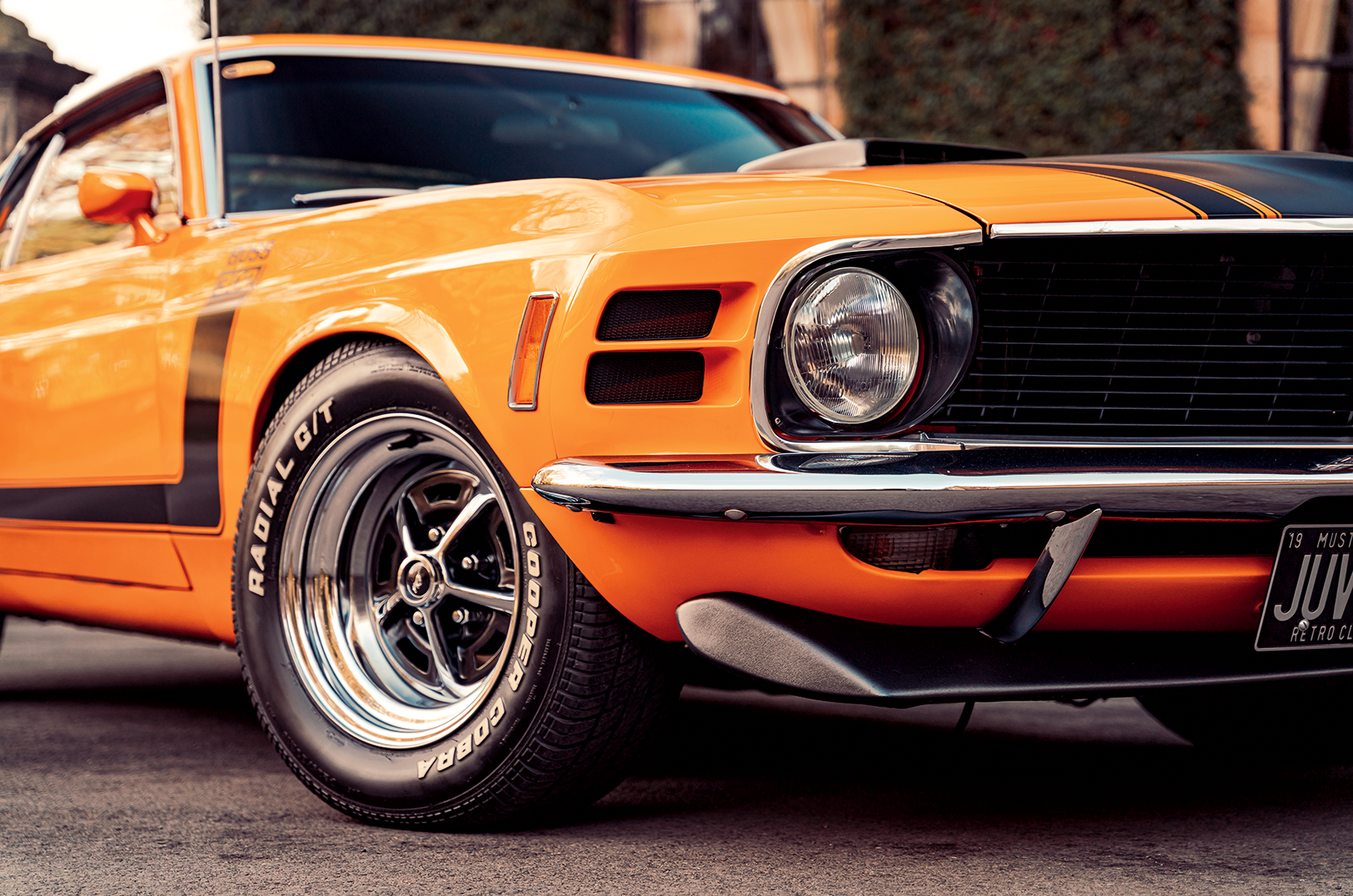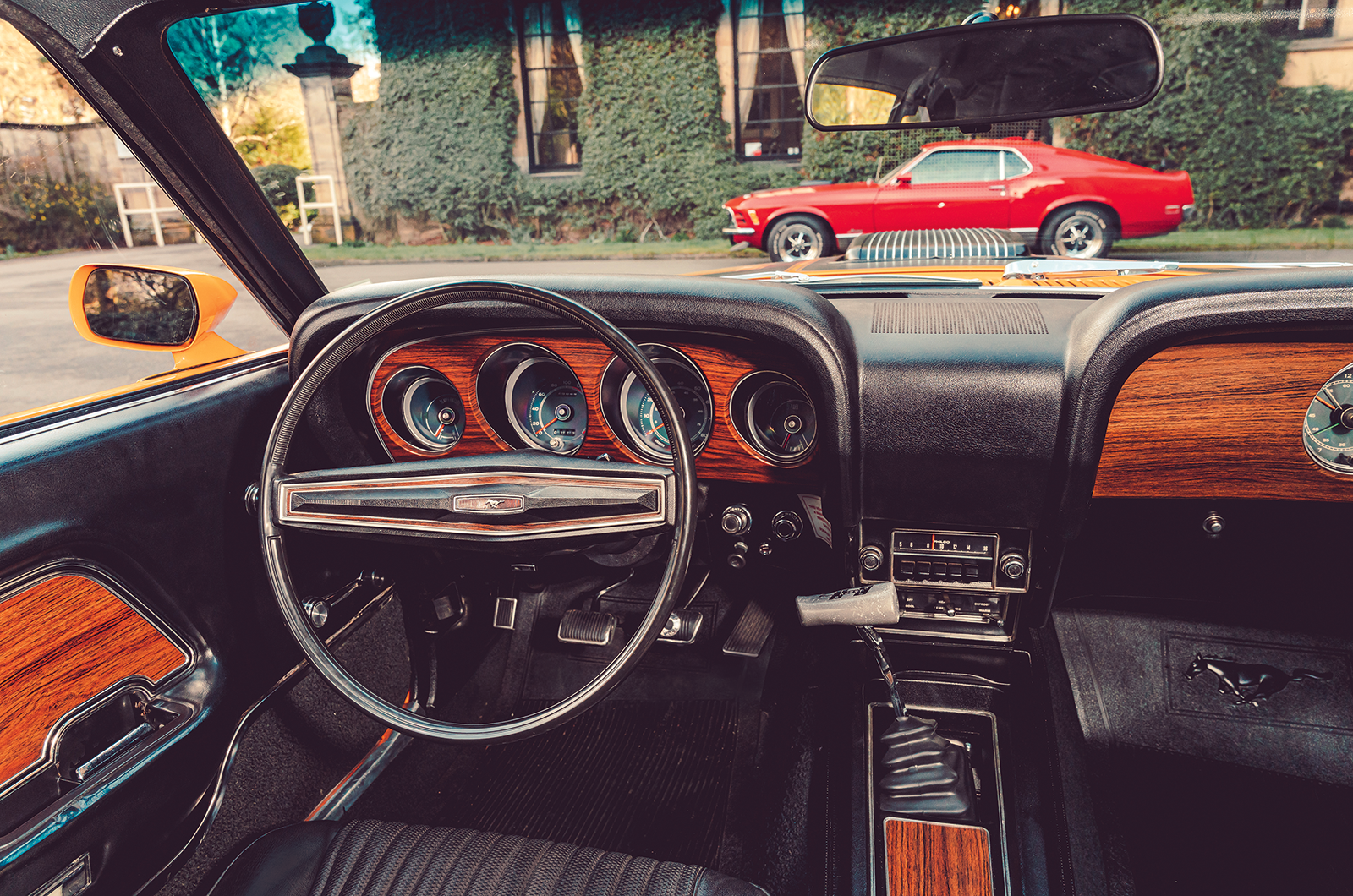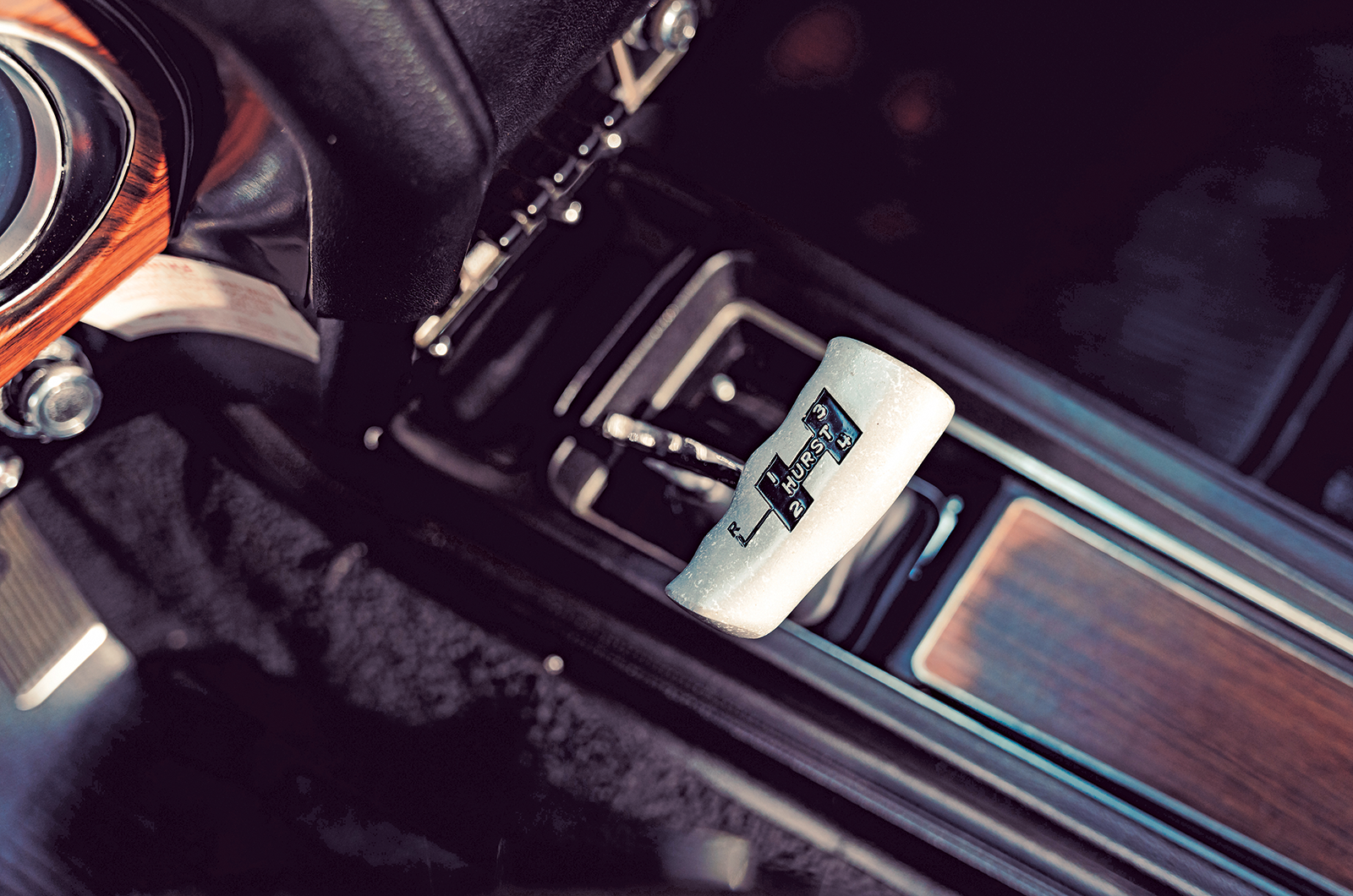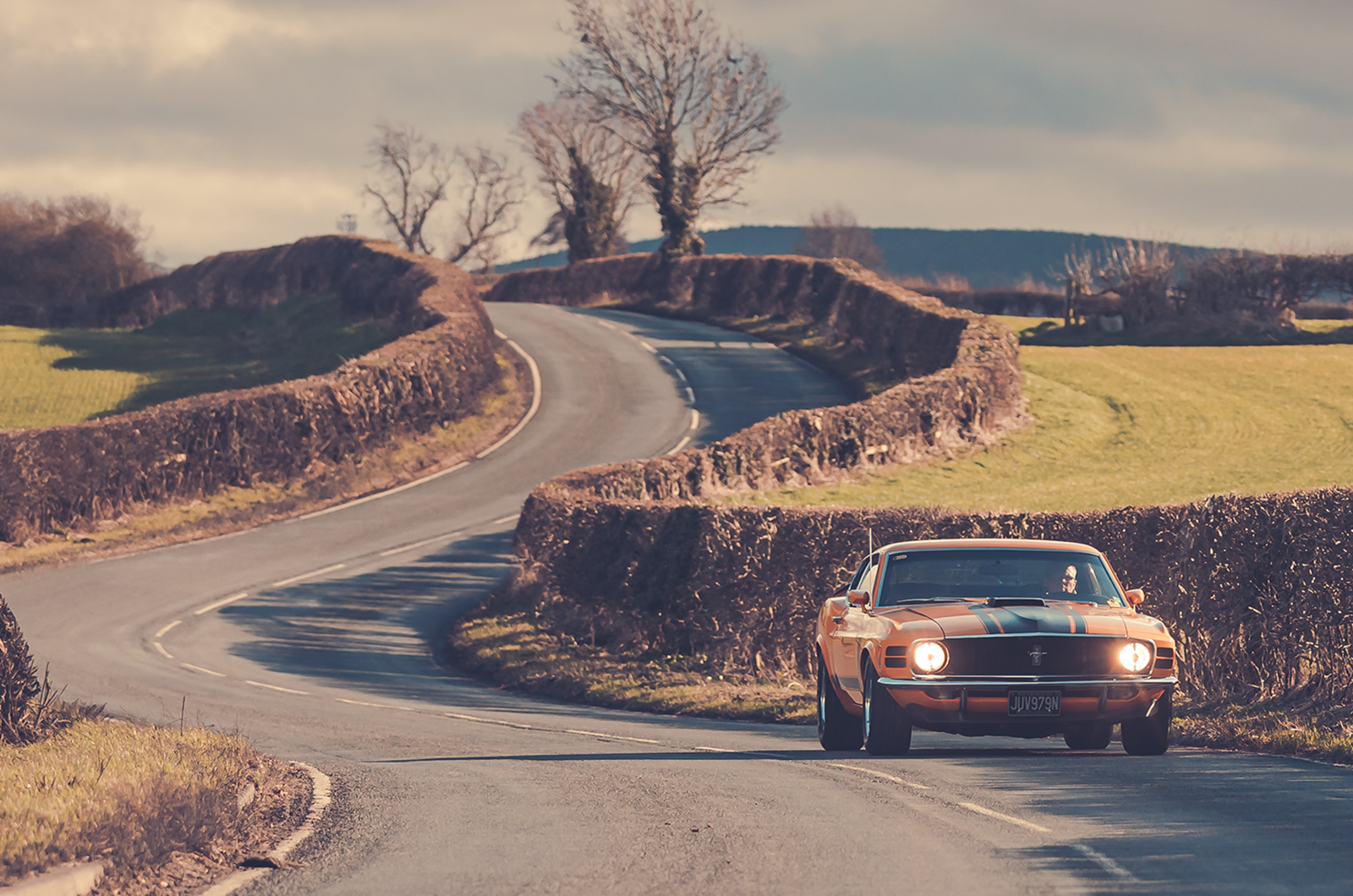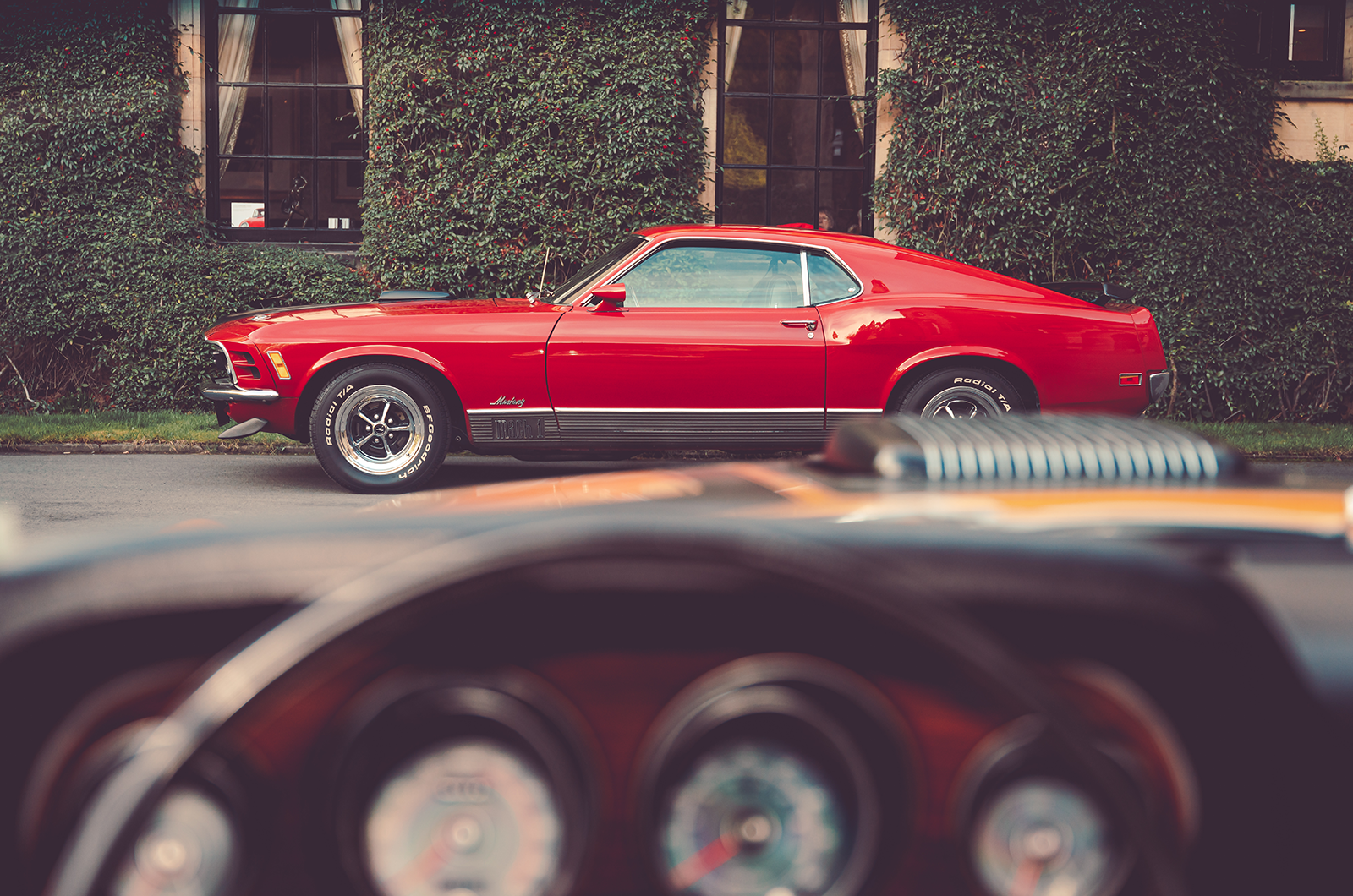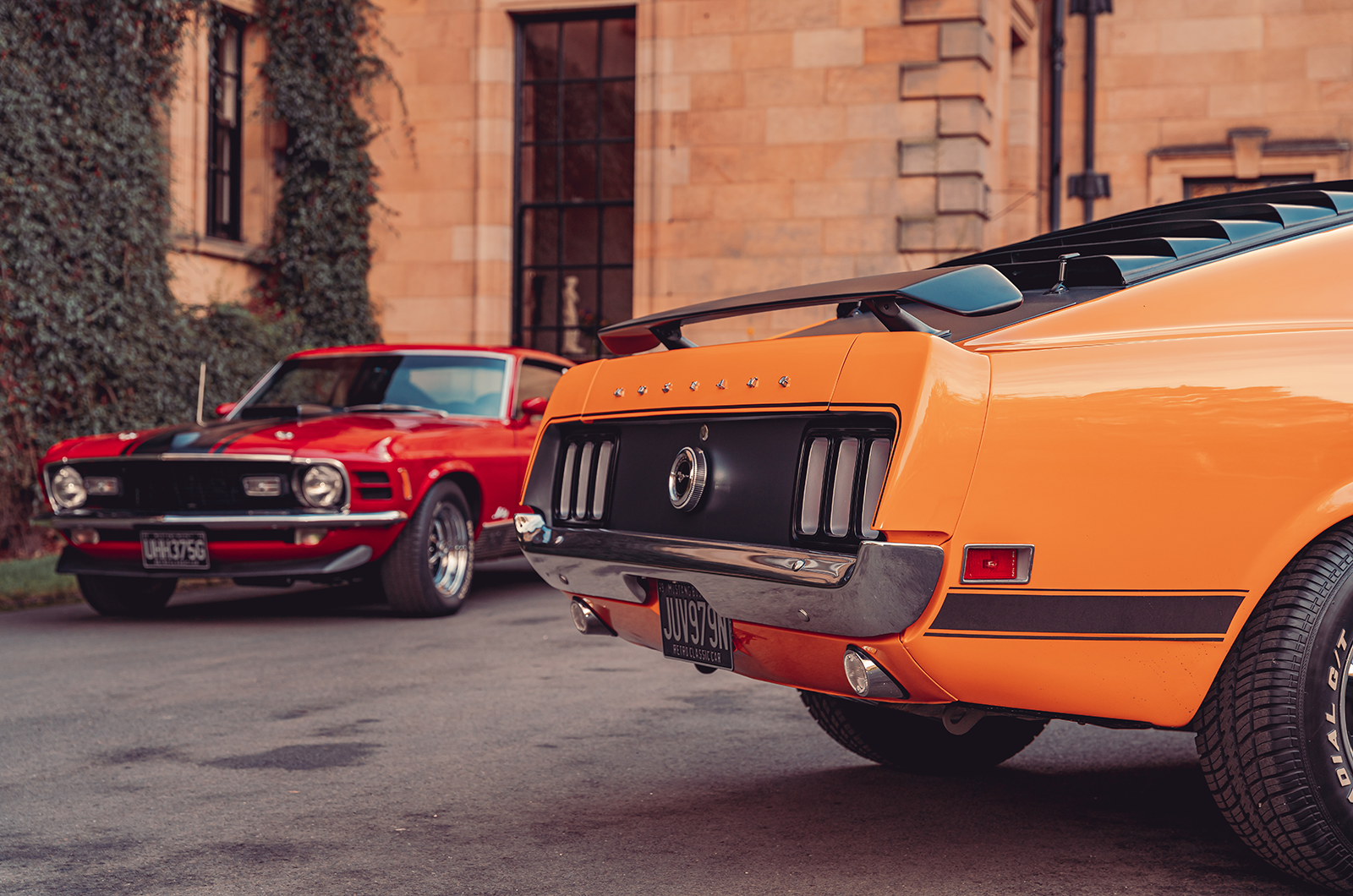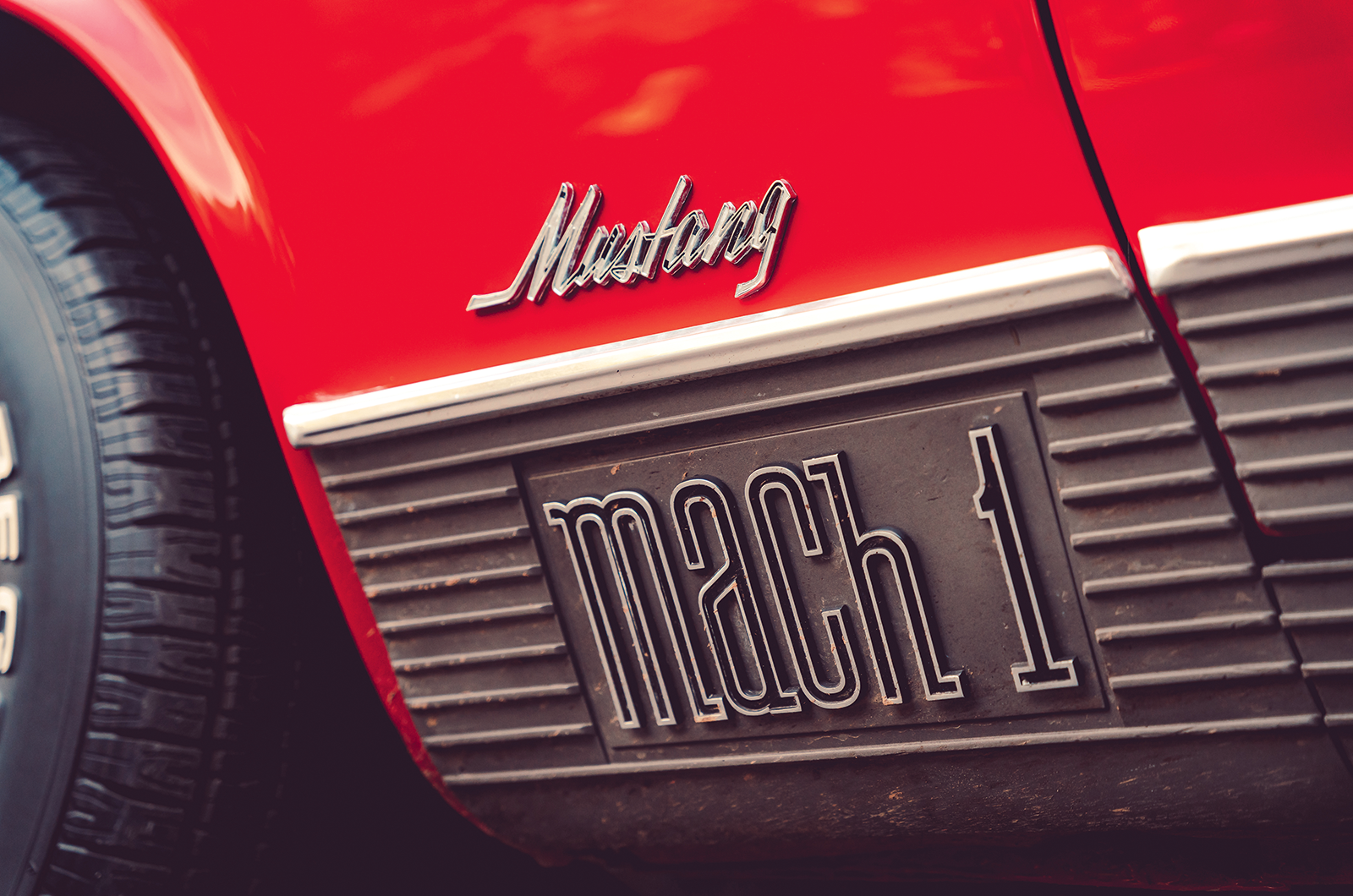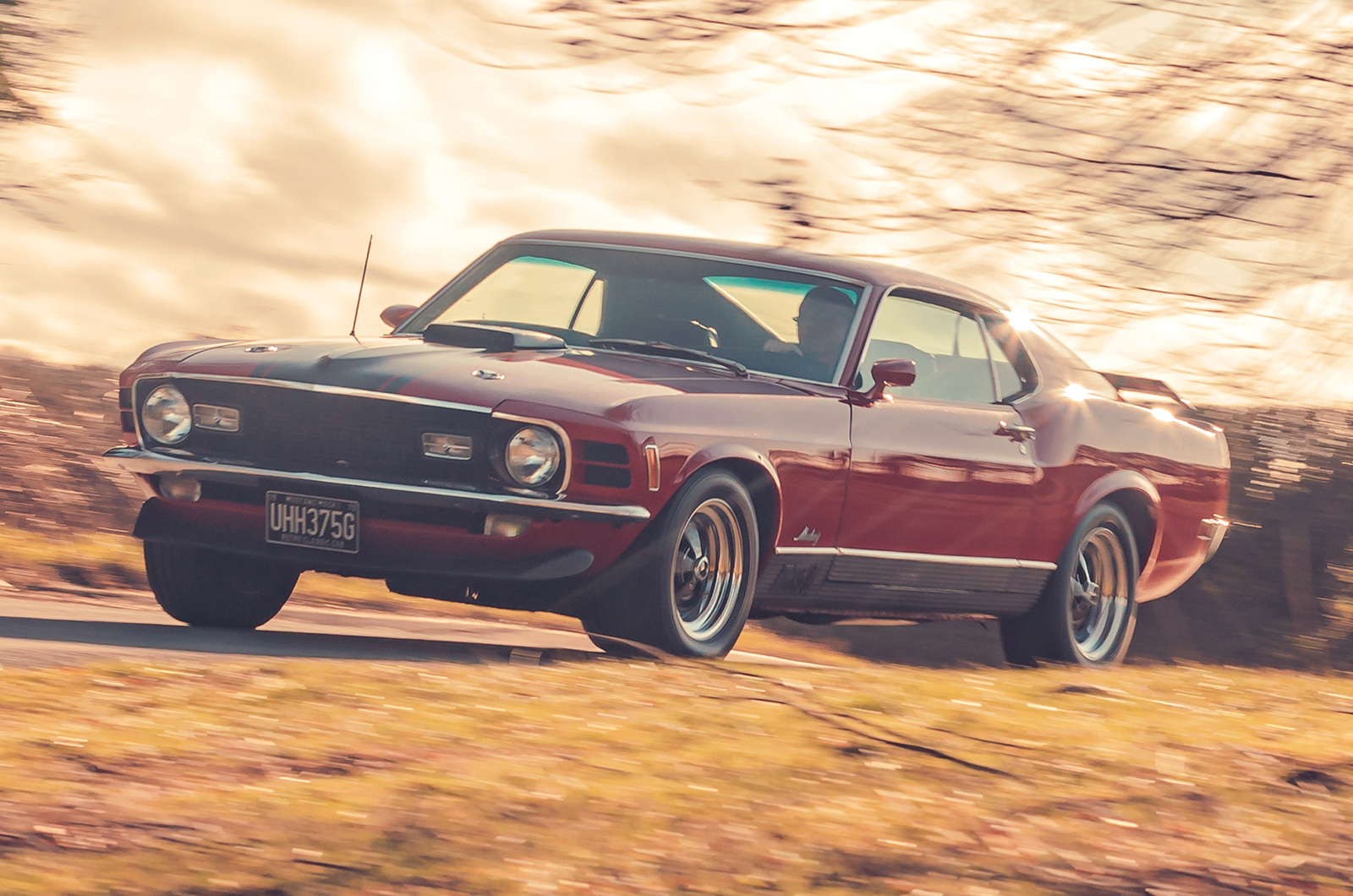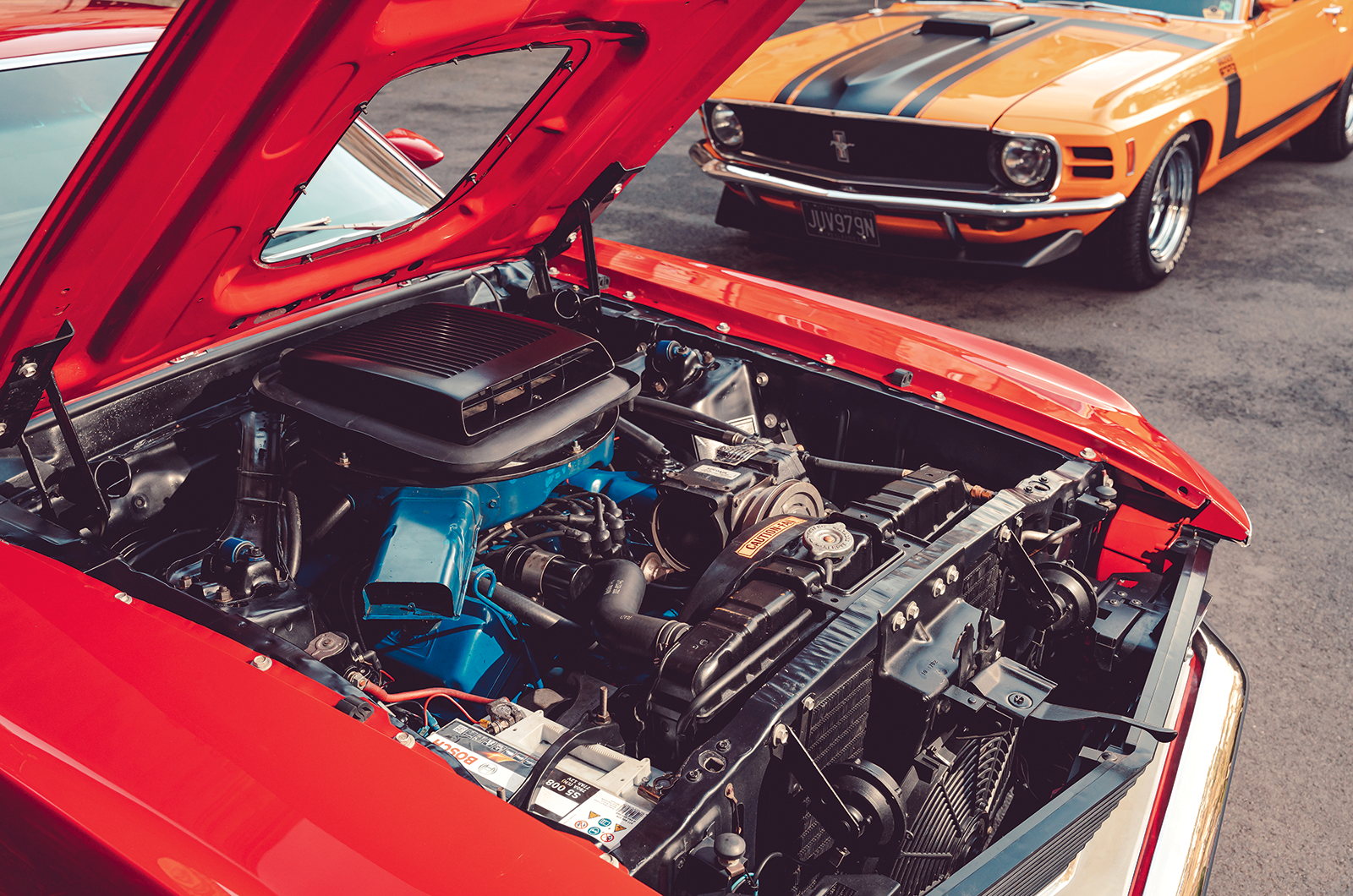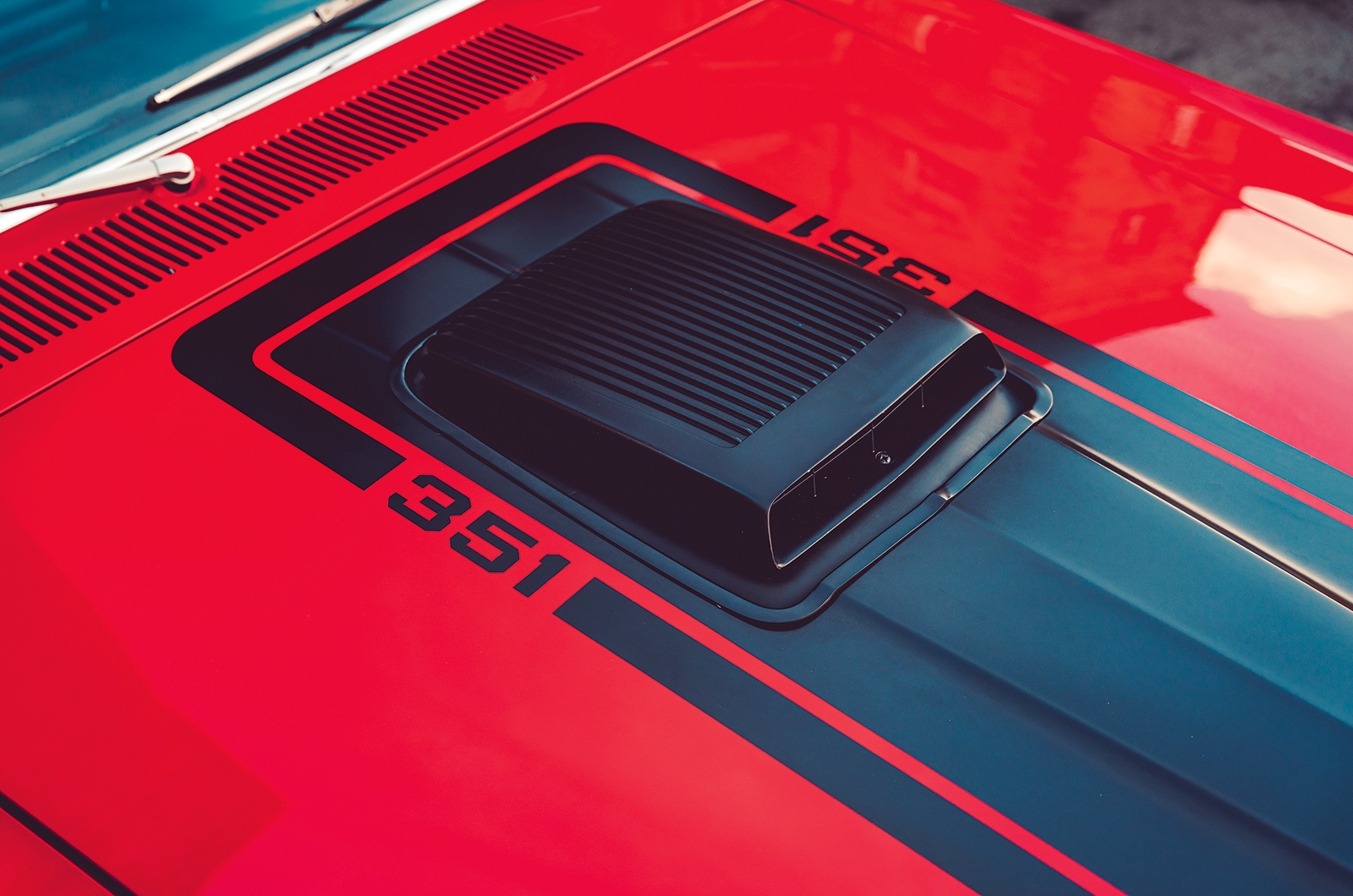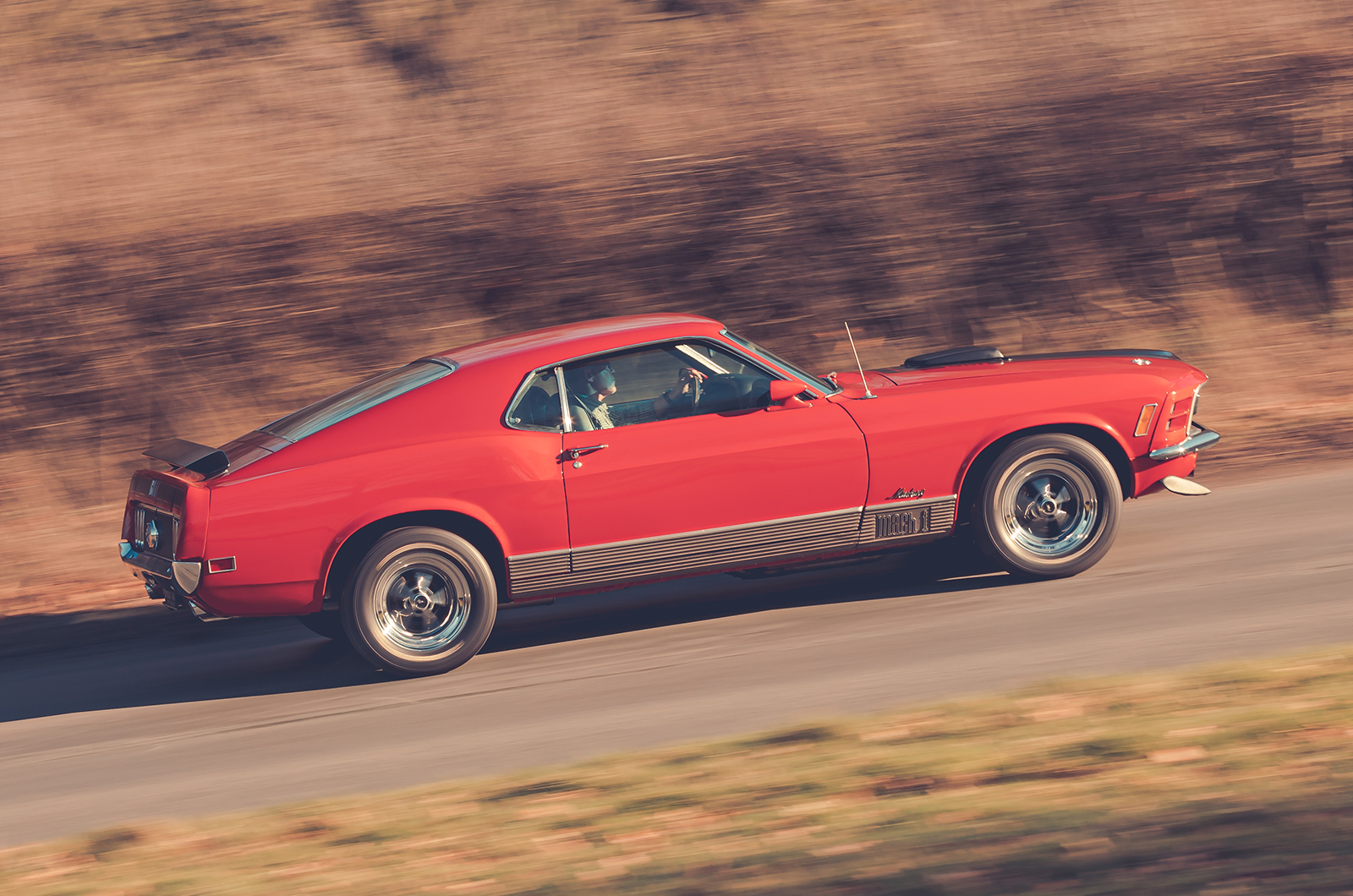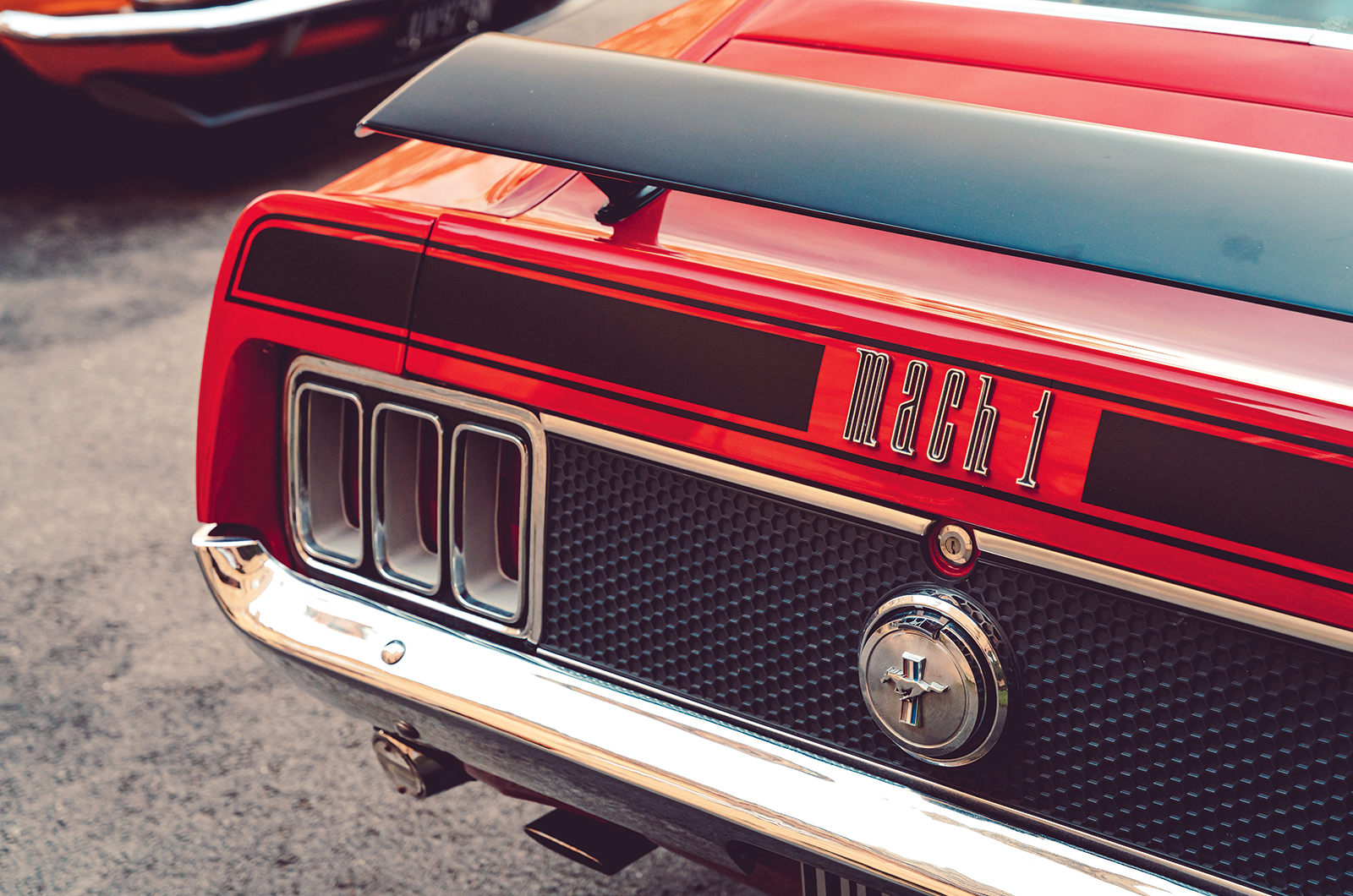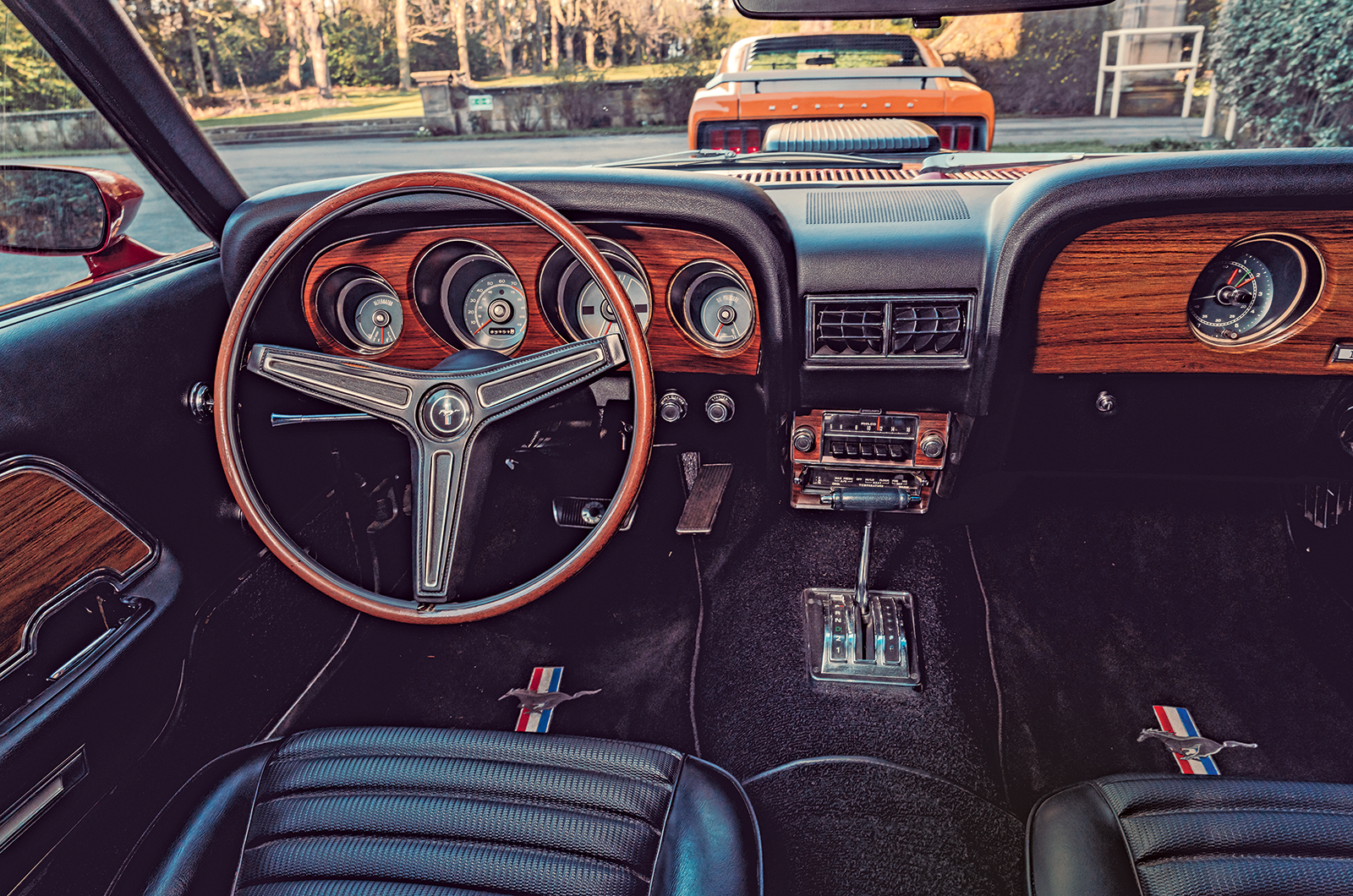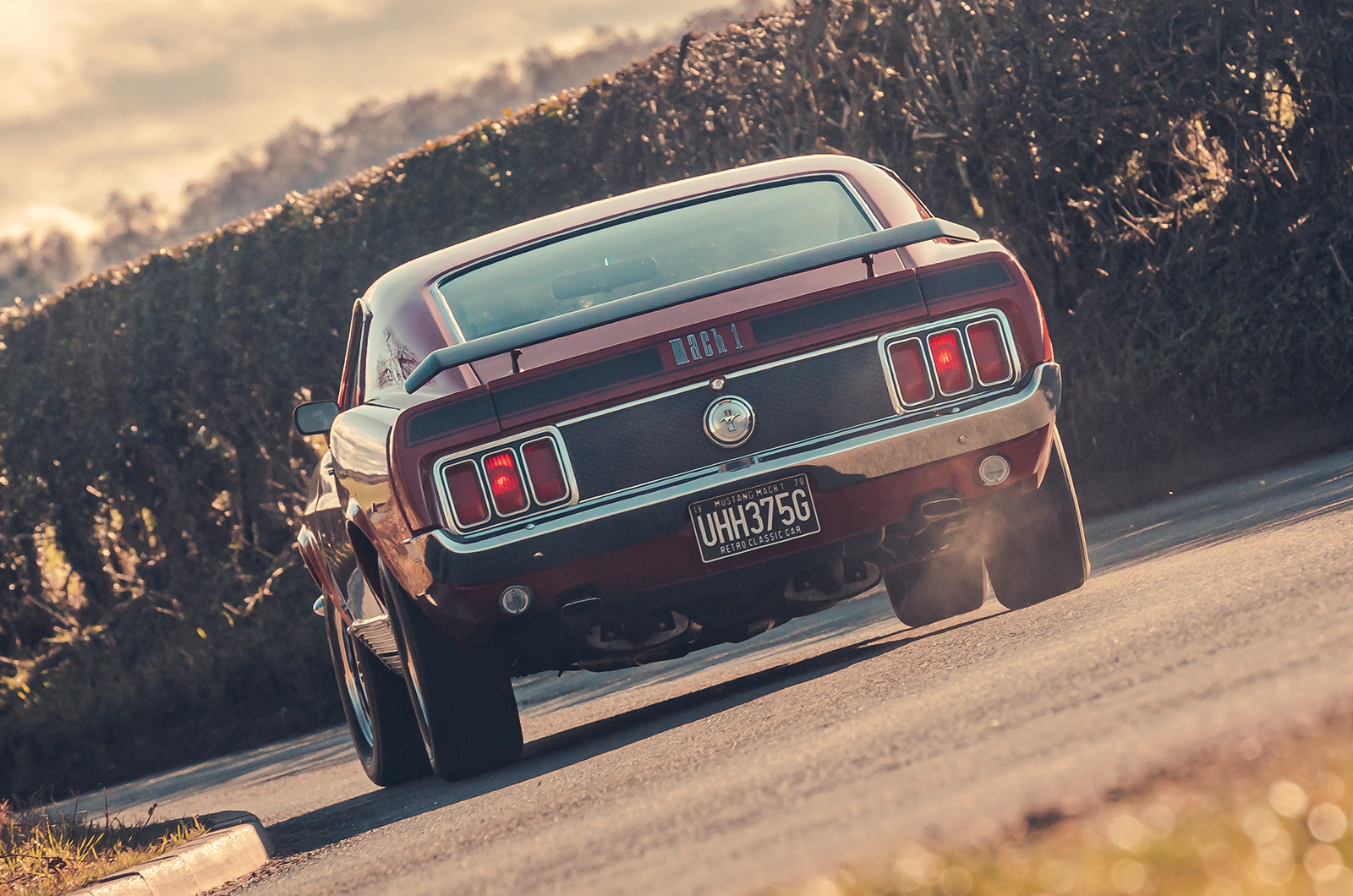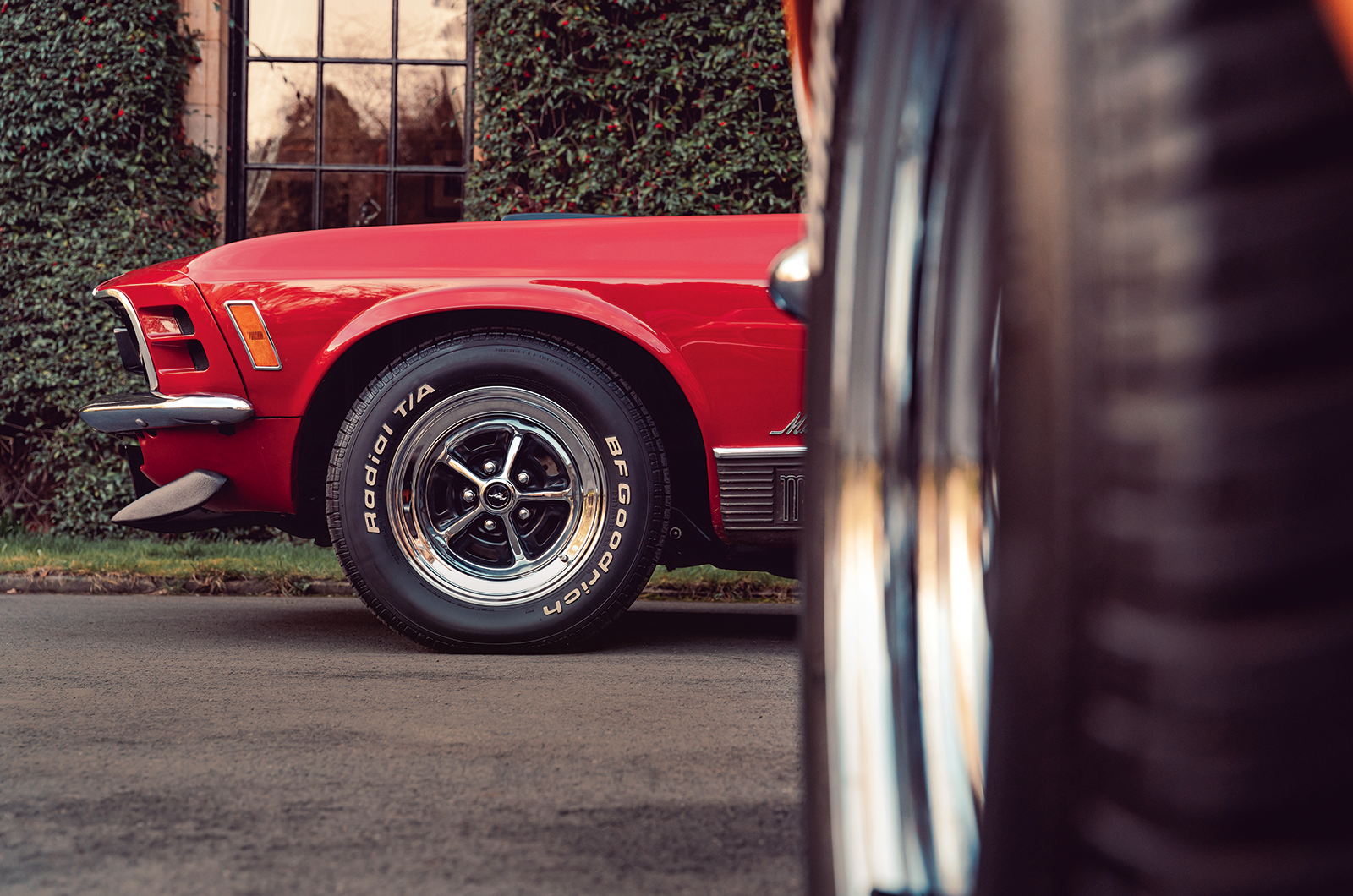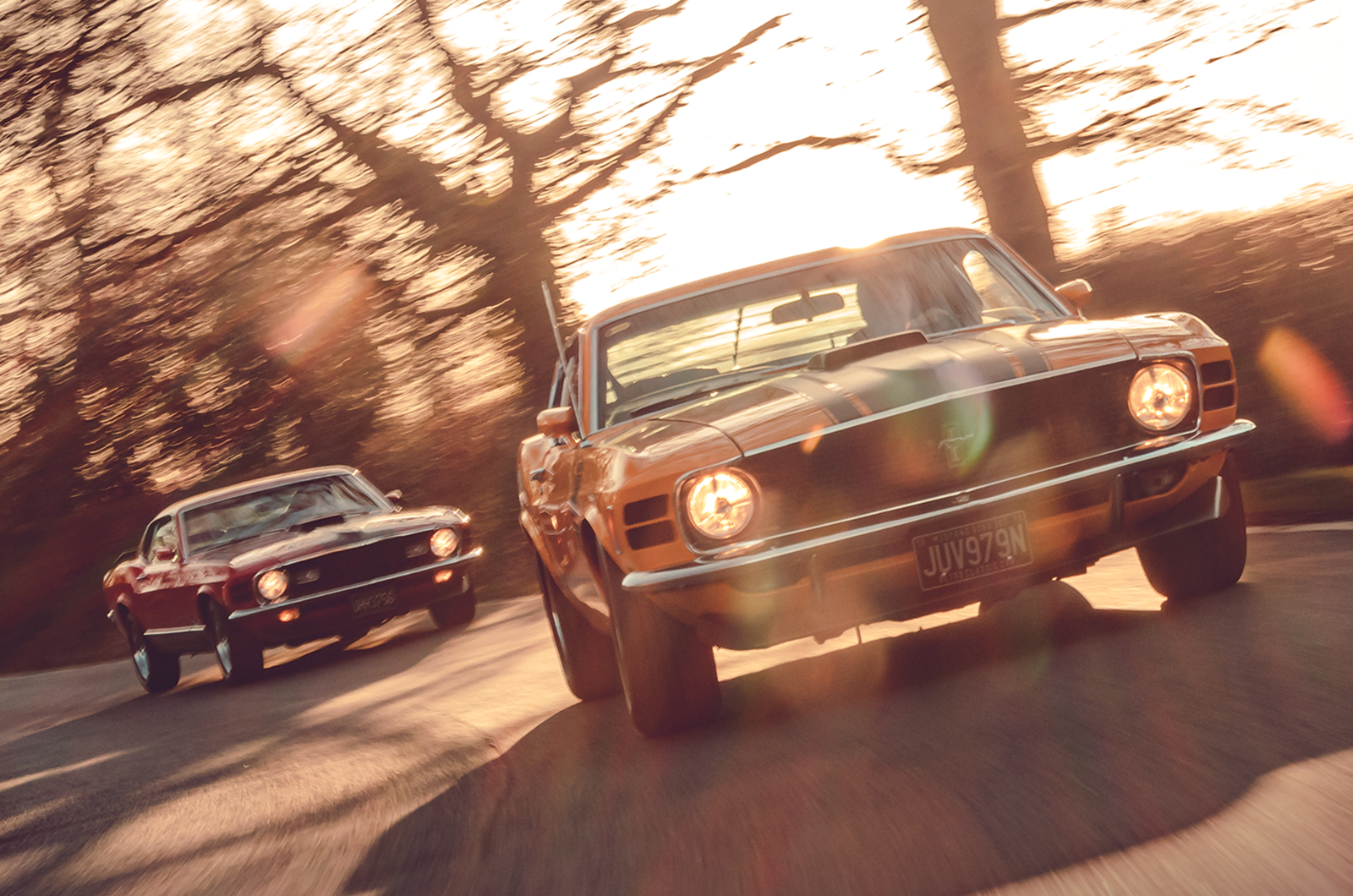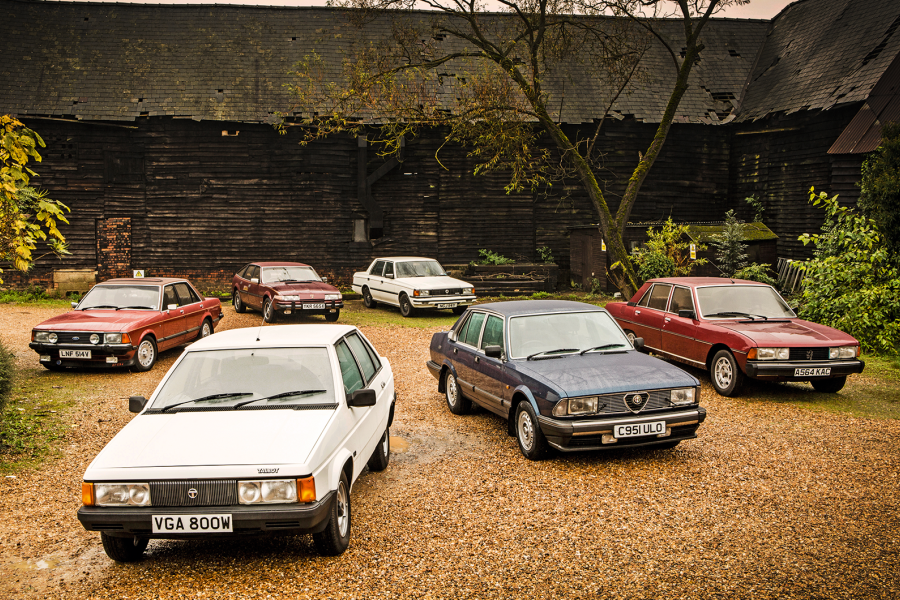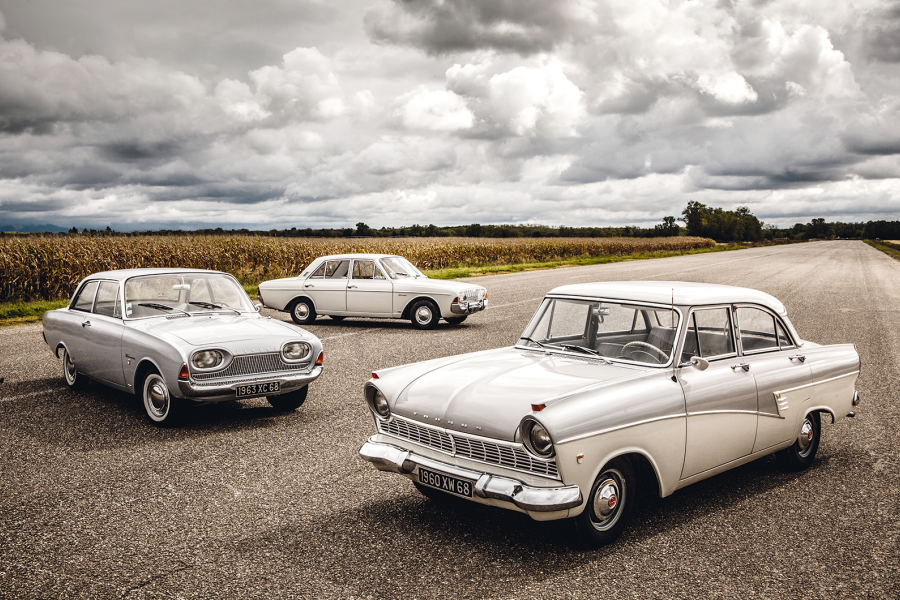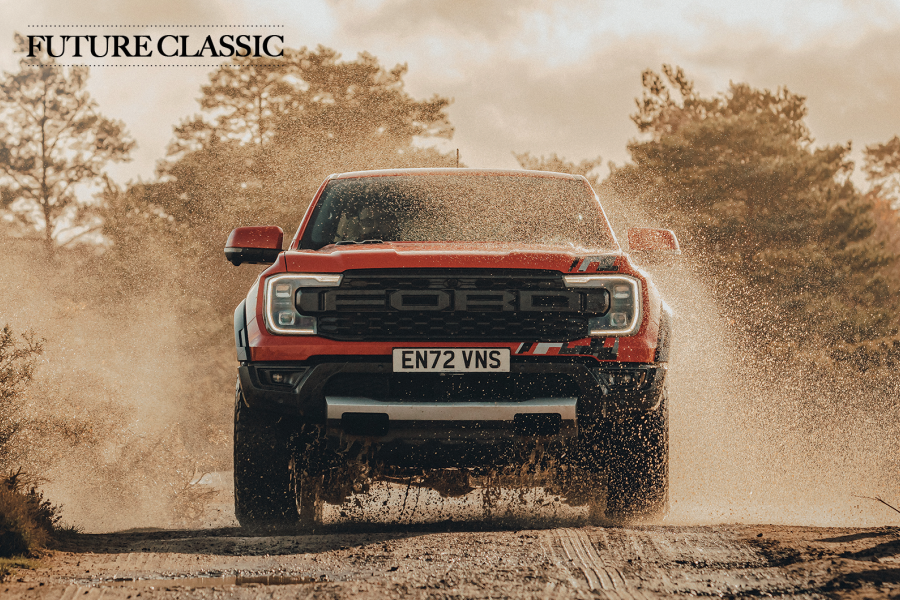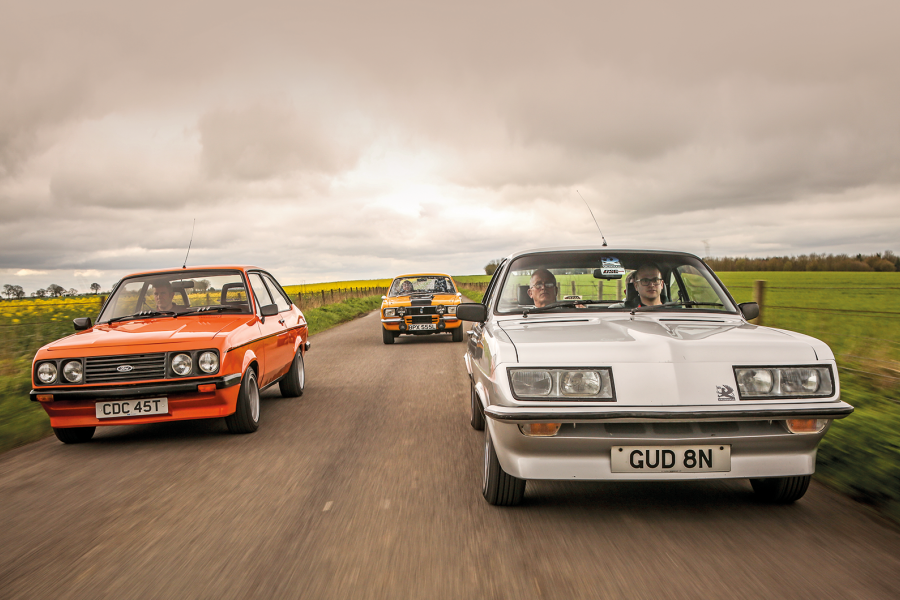Matching ‘teak’-trimmed binnacles appear on either side of the dash.
This Ford Mustang Mach 1 has the optional ‘Shaker’ hood
The passenger’s is inset with a clock and a reminder of the model’s name, and the driver’s with four dials covering all the basic systems – speed, oil pressure, battery charge – but with no optional rev counter.
Fire up the V8 and there’s no musclebound bark from the exhaust, rather a more subdued but still unmistakably Detroit-born burble.
Retro’s car runs a standard production exhaust, although most buyers would have upgraded to something louder and prouder back in the day.
And this, allied to its smooth-shifting FMX three-speeder, gives the Mach 1 a relaxed gait at odds with its aggressive appearance.
This Mach 1 Mustang’s exhaust is somewhat muted
It rides with civilised aplomb on its 65-profile 15in BF Goodrich tyres, and while cop-show-style tyre-squeal at even moderate cornering speeds is par for the course, the large body is well controlled for an early ’70s American.
Steering is as you’d expect: light, with a dead zone just off centre, but reasonably accurate for a car modelled around the dragstrip.
The single most annoying part of cornering, as you grip the wheel to turn in, is the ‘easy-honk’ (aka ‘Rim Blow’) function, which surrounds the inner diameter of the steering wheel.
None of that prepares you for the Boss, though.
The boot spoiler is one of many factory options on this Mach 1
Sure, the Grabber Orange paint of this car, built for export and arriving in the UK in 1974 (hence the ‘N’ registration suffix), only covers subtly sportier bodywork, but from there the contrasts are more marked.
Inside, a rather prosaic-looking two-spoke steering wheel (thankfully, less the dreaded Rim Blow) is a disappointment after the Mach’s three-spoke, but the basic dash layout gains a rev counter.
And replacing the Mach’s auto is the Hurst manual shifter sprouting from the centre console, its metal grip looking more like an inverted golf putter.
The three-spoke wheel in the Mach 1 includes the added hazard of the ‘Rim Blow’ horn function
Start up, and the Boss soundtrack is raw and hearty, instantly beating the Mach’s decibel count.
Getting it off the line needs plenty of revs and noise, too, betraying its race-bred origins.
To drive it is a more physical experience, from the effort needed to select first to the heavyish, long-travel clutch.
There’s little action below 2000rpm, but then the hammering, hardcore V8 soundtrack grows to a rebel yell and you’re suddenly on track at Darlington.
It doesn’t take an excess of enthusiasm to get the Mach 1 squealing its tyres in corners
The Boss thrives on revs, its sweet spot between 4000 and 5000rpm, just below peak power.
The car feels more hunkered-down on the road and the ride is much firmer than the Mach 1’s.
But more engaging? It would be, but for steering that is curiously inconsistent: there’s a disconcerting lack of feedback just off-centre, making fast, tighter turns a guessing game at first – is it gripping or not? But it does.
Push harder and convince yourself that the Cooper Cobras are going to keep you on the black stuff and the car corners remarkably well for a 3392lb motor.
The Goodrich tyres on the Ford Mustang Mach 1 give a supple ride
No tyre squeal, some roll over the rear axle – which feels right, somehow – and the only other challenge is the recalcitrant gearshift: it always needs a firm hand, but downchanging from third to second is a hit-and-miss affair, and to select any gear a stronger arm is required as heat builds up in the powertrain.
I’m not going to pretend that either Mustang provides driving nirvana on UK roads: both are pretty blunt tools, at odds with their apparent agility displayed in countless Hollywood car chases.
But they pack a brutalist charisma like few other classics, and if the Mach 1’s exhaust could be made a touch fruitier, I might just be tempted to adopt my first American.
Images: Max Edleston
Thanks to: Retro Classic Car for both Mustangs; Crathorne Hall Hotel
Factfiles
Ford Mustang Boss 302
- Sold/number built 1969-’70/7013
- Construction steel monocoque
- Engine all-iron, ohv 302cu in (4949cc) V8, single Holley four-barrel carburettor
- Max power 290bhp @ 5800rpm
- Max torque 290lb ft @ 4300rpm
- Transmission four-speed manual, RWD
- Suspension: front independent, by upper wishbones, single lower arms with drag struts, coil springs, anti-roll bar rear live axle, semi-elliptic leaf springs; telescopic dampers f/r
- Steering power-assisted recirculating ball
- Brakes vented discs front, drums rear
- Length 15ft 7½in (4674mm)
- Width 5ft 11¾in (1821mm)
- Height 4ft 2¼in (1275mm)
- Wheelbase 9ft (2743mm)
- Weight 3392lb (1539kg)
- Mpg n/a
- 0-60mph 6.5 secs
- Top speed 137mph
- Price new $3720
- Price now £100,000*
Ford Mustang Mach 1
- Sold/number built 1969-’70/113,428 (all Mach 1 derivatives)
- Construction steel monocoque
- Engine all-iron, ohv 351cu in (5752cc) V8, single two-barrel carburettor
- Max power 250bhp @ 5400rpm
- Max torque 355lb ft @ 3400rpm
- Transmission three-speed auto, RWD
- Suspension: front independent, by upper wishbones, single lower arms with drag struts, coil springs, anti-roll bar rear live axle, semi-elliptic leaf springs; telescopic dampers f/r
- Steering power-assisted recirculating ball
- Brakes drums
- Length 15ft 7½in (4674mm)
- Width 5ft 11¾in (1821mm)
- Height 4ft 2¼in (1275mm)
- Wheelbase 9ft (2743mm)
- Weight 3406lb (1545kg)
- Mpg n/a
- 0-60mph 7.9 secs (manual)
- Top speed 128mph (manual)
- Price new $3271
- Price now £50,000*
*Prices correct at date of original publication
Enjoy more of the world’s best classic car content every month when you subscribe to C&SC – get our latest deals here
READ MORE
Your classic: Ford Mustang
Muscle-car shoot-out: Chevrolet Camaro SS 396 Indy Pace Car vs Shelby GT500 Cobra Jet
Shelby GT500 KR: hail to the king
Simon Hucknall
Simon Hucknall is a senior contributor to Classic & Sports Car
